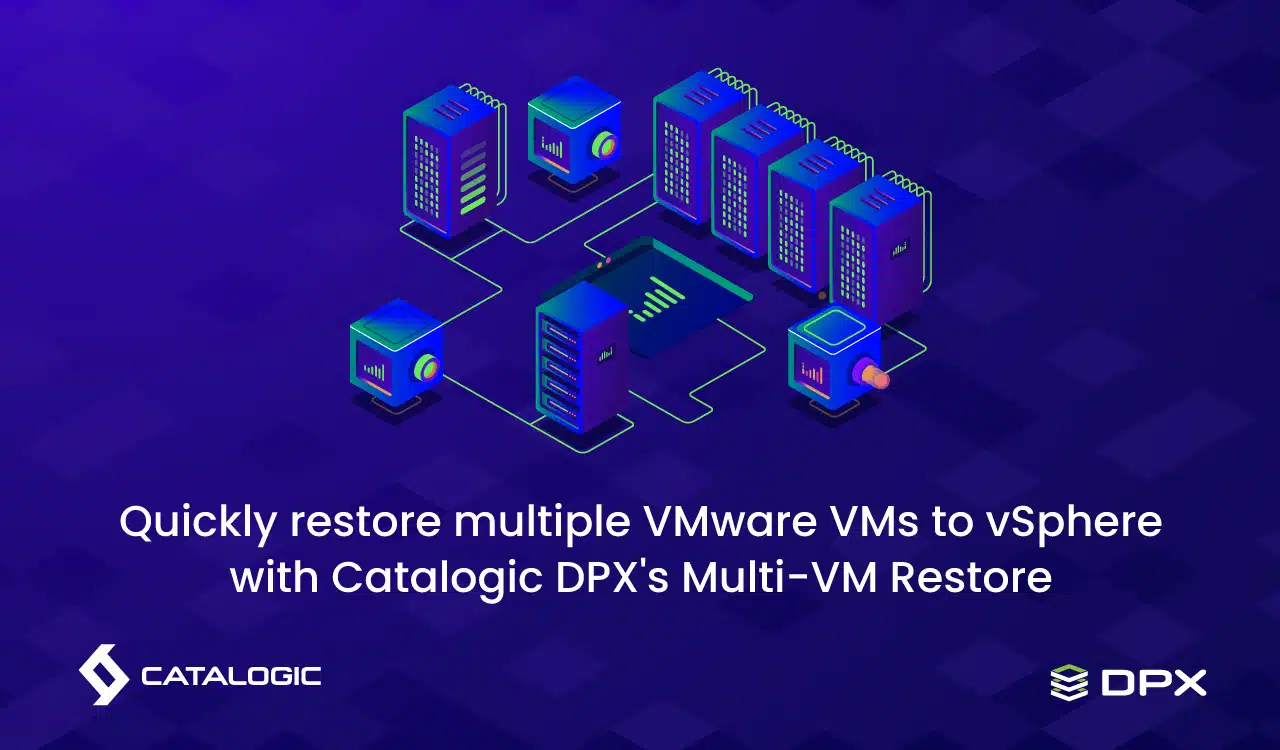How to Simultaneously Restore Multiple VMware Virtual Machines with DPX

Restoring virtual machines (VMs) after a system failure can be a slow and demanding process. Each VM needs careful attention to get systems up and running again, leading to long recovery times. The new multi-VM restore feature in Catalogic DPX aims to speed up these recoveries, making disaster recovery faster and easier for IT departments.
The Traditional VM Restore Challenges
Traditionally, the VM restoration process has been a linear and methodical sequence of steps that IT teams must navigate following a system failure or data loss event. This process typically involves:
- Identifying the Affected VMs: The initial step involves a meticulous assessment to pinpoint which VMs on the server have been compromised by the incident.
- Restoring VMs Sequentially: IT professionals then embark on the labor-intensive task of restoring each VM individually – a process that can be incredibly time-consuming.
- Verifying Data Integrity and Configuration: After each VM is restored, it must undergo a thorough check to confirm that data integrity is intact and configuration settings are correctly applied.
- Managing Resource Allocation: Throughout the restoration process, careful management of IT resources is crucial to prevent overloading the system and affecting other ongoing operations.
This traditional approach to VM restoration not only prolongs system downtime but also exerts a significant demand on IT resources, underscoring the need for a more efficient recovery solution.
Parallelize Restoration Process with Catalogic DPX Multi-VM Restore
Catalogic DPX is set to introduce a multi-VM restore feature, a development awaited by many DPX users. This feature will enable the simultaneous restoration of multiple VMs, thereby reducing the time and complexity involved in recovering from a disaster or system failure.
The introduction of the multi-VM restore feature in Catalogic DPX represents a significant shift in how data recovery is approached, particularly in environments reliant on virtual machines. By enabling the simultaneous restoration of multiple VMs, this feature aims to address and overcome the limitations inherent in the traditional, sequential restoration process. Here is a closer look at the key benefits this feature is expected to deliver:
- Efficiency and Speed: Multi-VM restore will allow for a much faster recovery process, as multiple VMs can be restored in parallel, significantly reducing the time to full recovery.
- Simplified Management: The upcoming feature will offer a centralized management interface to display all the necessary details, making it easier for administrators to select and oversee the execution of the restoration of multiple VMs.
- Enhanced Disaster Recovery Preparedness: With the ability to restore multiple VMs quickly, organizations will be better equipped to handle unexpected disasters, ensuring minimal disruption to business operations.
This improvement can redefine disaster recovery efforts, making it a critical development for IT departments seeking to improve their resilience and operational efficiency.
Test Your Disaster Recovery Plan for Maximum Confidence
The upcoming multi-VM restore feature from Catalogic DPX is set to transform disaster recovery preparedness and testing. Consider a financial institution that relies heavily on data integrity and system availability. In the event of a system failure, the ability to swiftly restore multiple VMs simultaneously minimizes downtime and ensures that critical financial operations can resume without significant delays.
Furthermore, this feature enables organizations to conduct more comprehensive disaster recovery testing and validation. Organizations can test their DR plans in a controlled environment by simulating wide-scale disaster scenarios, such as a cyberattack or a natural disaster.
This not only helps in identifying potential weaknesses in the recovery strategy but also instills confidence in the organization’s ability to handle real-world incidents.
Replicate Production Environments Using Multi-VM Restore
Multi-VM Restore will also significantly impact the test and development landscape. Imagine a software development company working on the next big thing. The ability to quickly replicate production environments using multi-VM restore means that developers can test new features and updates in environments that mirror real-world conditions.
This not only accelerates the development cycle but also enhances the accuracy and reliability of testing. For instance, if a new application update requires compatibility testing across different VM configurations, the multi-VM restore feature allows for rapid setup and teardown of test environments, streamlining the development process and reducing time to market.
Seamless Integration with VMware
Catalogic DPX’s integration with VMware vSphere is designed to be seamless, providing robust backup and recovery capabilities that support both VMware Agentless Data Protection (VADP) and Storage Snapshots. This ensures that organizations can take full advantage of their virtual infrastructure and underlying hardware.
Change How You Work with Virtual Machines with Catalogic DPX
The upcoming multi-VM restore feature in Catalogic DPX is a testament to the continuous evolution of data protection and disaster recovery solutions. By offering a more efficient, manageable, and robust approach to VM restoration, Catalogic DPX is preparing organizations for a future where they can face IT disruptions with confidence. The new feature is a major upgrade for DPX users and a big step forward for IT experts in data protection and disaster recovery.

